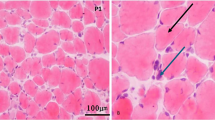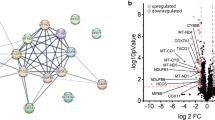Abstract
Apoptosis of skeletal muscle fibers is a well-known event occurring in patients suffering from muscular dystrophies. In this study, we hypothesized that functional polymorphisms in genes involved in the mitochondrial apoptotic pathway might modulate the apoptotic capacity underlying the muscle loss and contributing to intrafamilial and interfamilial variable phenotypes in LGMD2C (Limb Girdle Muscular Dystrophy type 2C) patients sharing the same c.521delT mutation in SGCG gene. Detection of apoptosis was confirmed on muscle biopsies taken from LGMD2C patients using the TUNEL method. We genotyped then ten potentially functional SNPs in TP53, BCL-2 and BAX genes involved in the mitochondrial apoptotic pathway. Potential genotype-dependent Bcl-2 and p53 protein expressed in skeletal muscle was investigated using western blot and ELISA assays. The result showed that muscle cells carrying the TP53-R72R and TP53-16 bp del/del genotypes displayed an increased p53 level which could be more effective in inducing apoptosis by activation of the pro-apoptotic gene expression. In addition, the BCL2-938 AA genotype was associated with increased Bcl-2 protein expression in muscle from LGMD2C patients compared to −938CC genotype, while there was no evidence of significant difference in the BAX haplotype. Our findings suggest that increased Bcl-2 protein expression may counteract pro-apoptotic pathways and thus reduce the muscle loss. To the best of our knowledge, this is a pioneer study evaluating the role of apoptotic BCL-2 and TP53 genes in contributing to the phenotypic manifestation of c.521delT mutation in LGMD2C patients. Larger studies are needed to validate these findings.




Similar content being viewed by others
References
Webb J (1977) Cell death in developing skeletal muscle: histochemistry and ultrastructure. J Pathol 123:175–180
Fidzianska A, Goebel H (1990) Human ontogenesis: cell death in fetal muscle. Acta Neuropathol 81:572–577
Carraro U (1995) Apoptotic death of dystrophic muscle fibers after exercise: a new hypothesis on the early events of muscle damage. Basic Appl Myol 5:371–374
Podhorska-Olokov M, Sandri M, Bruson A et al (1995) Apoptotic myonuclei appear in adult skeletal muscles of normal and mdx mice after mild exercise. Basic Appl Myol 5:87–90
Tews DS, Goebel H (1997) Apoptosis-related proteins in skeletal muscle fibers of spinal muscular atrophy. J Neuropathol Exp Neurol 56:150–156
Tews DS, Goebel H (1997) DNA-fragmentation and expression of apoptosis-related proteins in muscular dystrophies. Neuropathol Appl Neurobiol 23:331–338
Schneider C, Gold R, Dalakas M et al (1996) MHC class I-mediated cytotoxicity does not induce apoptosis in muscle fibers nor in inflammatory T cells: studies in patients with polymyositis, dermatomyositis and inclusion body myositis. J Neuropathol Exp Neurol 55:1205–1209
Olivé M, Mtnez-Matos JA, Montero J et al (1997) Apoptosis is not the mechanism of cell death of muscle fibers in human muscular dystrophies and inflammatory myopathies. Muscle Nerve 20:1328–1330
Pellegrino MA, Desaphy JF, Brocca L et al (2011) Redox homeostasis, oxidative stress and disuse muscle atrophy. J Physiol 589:2147–2160
Dam AD, Mitchell AS, Rush JWE, Quadrilatero J (2011) Elevated skeletal muscle apoptotic signaling following glutathione depletion. Apoptosis. doi:10.1007/s10495-011-0654-5
Marzetti E, Leeuwenburgh C (2006) Skeletal muscle apoptosis, sarcopenia and frailty at old age. Exp Gerontol 41:234–238
Marzetti E, Privitera G, Simili V et al (2010) Multiple pathways to the same end: mechanisms of myonuclear apoptosis in sarcopenia of aging. Sci World J 19:340–349
Angelini C, Fanin M, Freda MP et al (1999) The clinical spectrum of sarcoglycanopathies. Neurology 52:176–179
Sandona D, Betto R (2009) Sarcoglycanopathies: molecular pathogenesis and therapeutic prospects. Expert Rev Mol Med 11:e28. doi:10.1017/S1462399409001203
Vignos PJ, Spencer GE, Archibald KC (1963) Management of progressive muscular dystrophy of childhood. J Am Med Assoc 194:89–96
Zhibin H, Chunying L, Kexin C et al (2008) Single nucleotide polymorphisms in selected apoptotic genes and BPDE-induced apoptotic capacity in apparently normal primary lymphocytes: a genotype–phenotype correlation analysis. J Cancer Epidemiol. doi:10.1155/2008/147905
Chen K, Hu Z, Wang LE et al (2007) Single-nucleotide polymorphisms at the TP53-binding or responsive promoter regions of BAX and BCL2 genes and risk of squamous cell carcinoma of the head and neck. Carcinogenesis 28:2008–2012
Rajini S, Barkha P, Hamadeh J (2009) Comparison of total protein concentration in skeletal muscle as measured by the Bradford and Lowry Assays. J Biochem 145:791–797
Hack A, Chantal T, Fang J et al (1998) γ-Sarcoglycan deficiency leads to muscle membrane defects and apoptosis independent of dystrophin. J Cell Biol 142:1279–1287
Miller JB, Girgenrath M (2006) The role of apoptosis in neuromuscular diseases and prospects for anti-apoptosis therapy. Trends in Mol Med 12:279–286
Dumont P, Leu J, Della Pietra A et al (2003) The codon 72 polymorphic variants of p53 have markedly different apoptotic potential. Nat Genet 33:357–365
Thomas M, Kalita A, Labrecque A et al (1999) Two polymorphic variants of wild-type p53 differ biochemically and biologically. Mol Cell Biol 19:1092–1100
Gemignani F, Moreno V, Landi S et al (2004) A TP53 polymorphism is associated with increased risk of colorectal cancer and with reduced levels of TP53 mRNA. Oncogene 23:1954–1956
Young RL, Korsmeyer SJ (1993) A negative regulatory element in the bcl-2 5′-untranslated region inhibits expression from an upstream promoter. Mol Cell Biol 13:3686–3697
Basset O, Boittin FX, Cognard C et al (2006) Bcl-2 overexpression prevents calcium overload and subsequent apoptosis in dystrophic myotubes. Biochem J 395:267–276
Danielssona O, Nilssonb C, Lindvallc B et al (2009) Expression of apoptosis related proteins in normal and diseased muscle: a possible role for Bcl-2 in protection of striated muscle. NMD 19:412–417
Acknowledgments
We are grateful to the family members for their invaluable cooperation. We are grateful to Pr. Raja Mokdad Gargouri from Centre of Biotechnology of Sfax, for providing us the p53 antibody. We also acknowledge Mr. Jamil JAOUA, founder and former head of the English Unit at the Sfax Faculty of Science, Tunisia, for proofreading this paper.
Author information
Authors and Affiliations
Corresponding authors
Rights and permissions
About this article
Cite this article
Hadj Salem, I., Kamoun, F., Louhichi, N. et al. Impact of single-nucleotide polymorphisms at the TP53-binding and responsive promoter region of BCL2 gene in modulating the phenotypic variability of LGMD2C patients. Mol Biol Rep 39, 7479–7486 (2012). https://doi.org/10.1007/s11033-012-1581-4
Received:
Accepted:
Published:
Issue Date:
DOI: https://doi.org/10.1007/s11033-012-1581-4




